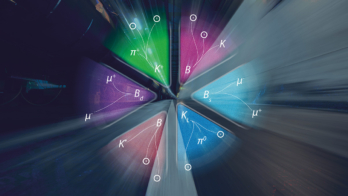
The problem of obtaining a precise measurement of one of the most elusive effects in particle physics has finally been overcome. After many years of uphill struggle, with sometimes conflicting results from different experiments, the parameter that measures the tiny matter-antimatter asymmetry of quarks has been found to be non-zero with almost complete certainty (six standard deviations).
From 1997 to 1999, the big NA48 experiment at CERN patiently accumulated data from the decays of neutral kaons. A preliminary analysis using only a portion of the data (May 2000 p6) reported that the vital charge/parity (CP) violation parameter was 14 ± 4.4 x 10-4. This was in line with an earlier NA48 measurement of 18.5 ± 7.3 x 10-4, but the same quantity reported in 1998 by the KTeV experiment at Fermilab was higher at 28 ± 4.1 x 10-4. The difference between the CERN and Fermilab results was difficult to reconcile*. However, the new CERN result, 15 ± 2.7 x 10-4, based on 20 million CP-violating decays of neutral kaons, each producing a pair of pions, has far better statistics than all previous measurements.
With CP symmetry, the physics of right-handed particles is the same as that of left-handed antiparticles (and vice versa). CP symmetry was introduced in the late 1950s, when physicists were stunned to discover that weak interactions (nuclear beta decays) are not left-right symmetric. In 1964 an experiment found that CP too was flawed.
The classic stage for such experiments is the neutral kaon – an enigmatic particle-antiparticle pair distinguished only by the obscure quantum number of strangeness. However, strangeness is only conserved in strong interactions, and in weak decays the neutral kaon particle and antiparticle get mixed up.
This mixing produces two clearly distinguishable kinds of neutral kaon – a variety that decays relatively easily into two pions and is therefore short-lived, and another that cannot slip easily into two pions and instead has to struggle to decay into three pions. The latter is therefore longer lived.
The 1964 experiment by Christenson, Cronin, Fitch and Turlay found that a few long-lived kaons in every thousand disobeyed the rules and instead decayed into two pions. CP was violated.
But there could be a deeper form of CP violation at work. Instead of arriving via the quantum mechanical mixing of neutral kaons, CP violation could also happen in the underlying quark transitions that are the cause of weak decays. If so, nature would have a way of distinguishing between quarks and antiquarks.
This “direct” CP violation could have occurred immediately after the Big Bang, when subnuclear particles began to freeze out of the primordial quark-gluon soup. Such an effect could help to explain the mystery of how a universe that appears to consist only of matter could have been produced from a Big Bang, which nevertheless produced equal numbers of particles and antiparticles.
To establish whether direct CP violation occurs and to measure it, physicists must carefully compare two ratios. The first is the rate of long-lived kaons decaying into two charged pions, compared with the decay rate into two neutral kaons. The second ratio is the equivalent pion pair comparison for short-lived kaons. If these two ratios were not exactly the same, then direct CP violation would occur.
Measuring this double ratio, which involves very similar particle signatures, is extremely difficult. NA48 uses simultaneous and collinear beams of short-lived and long-lived kaons and all decays are examined inside the same region. A large magnetic spectrometer analyses the charged pions, while a liquid-krypton calorimeter analyses the production of neutral pions.
The number of neutral kaon decays collected and analysed by NA48 is far greater than in any other experiment so far. The parameter used by physicists to measure this CP violation (e‘/e) is the difference of the double ratio from unity, divided by a numerical factor. The new NA48 result is 15 ± 2.7 x 10-4. Note the small errors, compared with earlier measurements. Combined with previous NA48 data, this gives 15.3 ± 2.6 x 10-4 and contributes to a world average figure of 18 ± 2 x 10-4.
Thus direct CP violation certainly happens. The classic “indirect” CP violation discovered in 1964 happens in a few decays in every thousand, and for every thousand indirect CP violations there are a few direct CP violations. Looking at the decays of the neutral kaon and its antiparticle into two oppositely charged pions, direct CP violation gives an asymmetry of 5 ± 0.9 x 10-6. The universe can discriminate between matter and antimatter, and even the resulting tiny imbalance of a few decays per million is apparently enough to ensure the demise of Big Bang antimatter.
NA48 was brought to a halt by an accident to its high-tech carbon fibre beam pipe in 1999, but this damage has since been repaired and the experiment is set to continue its careful analysis of neutral kaon decays.
*On 8 June, the KTeV experiment at Fermilab announced a reanalysis of their earlier result, giving (23.2 ± 3.0 ± 3.2) x 10-4, and a new result of (19.8 ± 1.7 ± 2.3) x 10-4.





